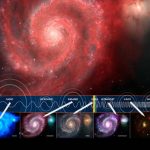Glossary of Radio Astronomy Terms
Eagle Nebula:
A bright nebula surrounding a cluster of new-born stars that has been designated as M16 or NGC 6611.

Early Type Star:
A hot star of spectral type O, B or A.

Eccentricity:
Measurement of how much an orbital path deviates from a perfect circle.

Eclipse:
A partial or total obstruction of light from a celestial body caused by an object passing between it and another body. (Example: When Earth’s Moon casts a shadow between the light coming from the Sun and Earth.

Ecosphere:
The shell-shaped region of space surrounding a star that holds a suitable temperature range in order to sustain life.

Einstein, Albert:
A German, Swiss and American theoretical physicist whose work has had a tremendous impact on science from the 20th century to present day. He is famously known for his special and general theories of relativity that relate space, time, and gravity.

Einstein Ring:
A ring- or arc-like image created when light emitted from a distant source is bent by the gravitational influence of a massive foreground object. This effect is called gravitational lensing; it allows astronomers to observe objects that would otherwise be too distant to study.

Einstein’s Postulates of Special Relativity:
The two assumptions Einstein took to be true when developing his theory of special relativity. The first, the laws of physics are the same for all inertial reference frames. The second, the speed of light in a vacuum is constant regardless of the motion of the source or observer.
Ejecta:
Material that is thrown out during an event, such as two objects colliding or a stellar explosion.

Electromagnetic Radiation:
A collective term for radiation from oscillating electric and magnetic fields. Examples of electromagnetic radiation include gamma rays, X-rays, ultraviolet, visible light, infrared, microwave, and radio waves.

Electron:
A negatively charged particle commonly found in the outer layers of atoms.
Element:
A substance that cannot be chemically broken down into simpler materials. They are arranged on the Periodic Table based on the number of protons a single atom of a certain type would contain.

Ellipse:
A geometric shape made up of a closed curve that contain two focal points. For any point on the curve the sum of the distances to the two focal points must be constant. In general, the orbits of celestial objects are elliptical.

Elliptical Galaxy:
A galaxy that appears round or elliptical in shape, typically containing little gas and dust, no spiral arms or disk, mostly older stars, which range in shape from spherical to “football” shaped, and few hot, bright stars.

Emersion:
The reappearance of a celestial body from the shadow of another after it has been eclipsed or occulted.
Emission Line:
A bright line in a spectrum caused by the emission of photons from atoms. Astronomers use radio telescopes to identify specific emission lines to detect specific chemical and molecules throughout the cosmos.

Emission Nebula:
A nebula formed by a cloud of gas that emits different colors through the ultraviolet radiation of hot stars within it.

Ephemeris:
A table giving the predicted positions of a celestial object such as a planet or comet, at given intervals.
Epoch:
A coordinate used to pinpoint an object on the celestial sphere during a fixed point in time (Ex: The location of Venus during early March)
Equinox:
Either of two points where the Sun crosses the celestial equator.
E=MC^2:
The equation for mass-energy equivalence created by Albert Einstein. It is a consequence of his Theory of Special Relativity and states that anything that has mass has some intrinsic energy.
Evection:
an irregularity in a moon’s motion caused by deviations in the sun or its planet’s motion.
Event Horizon:
The boundary surface of a black hole where nothing can escape, not even light.

European Space Agency:
An organization of European nations to promote space research and technology for peaceful purposes.

European Southern Observatory (ESO):
An institute of ten European countries, including the UK, that oversee several South American telescopes and observatories. These observatories include La Silla, Paranal, ALMA, APEX and the ELT.

Extraterrestrail:
A term used to describe anything that does not originate on Earth. SETI is the search for intelligent life outside of our planet.

Exobiology (Astrobiology):
The study of possible existence of life beyond Earth, also known as astrobiology.
Exoplanets:
Any planet (rocky or gas giant) orbiting a star other than the Sun. More than 3700 exoplanets have been detected to date.







